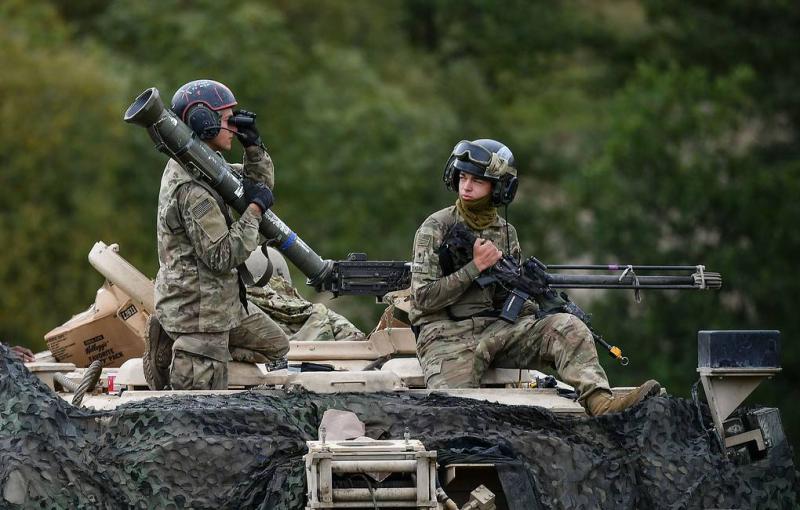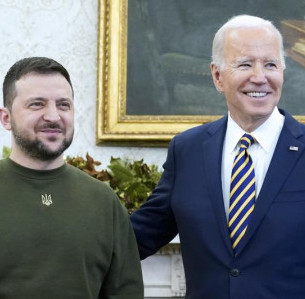
© EPA-EFE/PHILIPP GUELLAND/TASS
For three days running, Ukrainian militants have been striking Donetsk and other Donbass cities using foreign howitzers and multiple rocket launchers, staging artillery terror, sowing death and destruction.
New attacks occur with American M777 howitzers, French self-propelled Caesar guns, and also HIMARS missiles that deliver daily damage to deep rear cities of the of Donetsk republic – Snezhnoye, Torez, Khartsyzsk – and downtown Donetsk. The cities are engulfed in flames, columns of black smoke hang on the horizon, several dozen people are wounded and killed every day, numerous houses and enterprises get destroyed. In the neighboring Luhansk Republic, the Nazis used HIMARS to attack the rear cities of Perevalsk and Rovenki. So, NATO weapons have arrived in Ukraine to kill civilians.
American HIMARS systems are not only engaged in Donetsk, but also on the Kharkov and Zaporozhe directions. Recently, the General Staff of the Armed Forces of Ukraine published a relevant video, demonstrating the location of American arms. The US MLRSs are highly accurate and capable of swiftly changing deployment areas. A month ago this day, the United States announced its intention to hand four HIMARS multiple launch rocket systems over to Ukraine. Soldiers were quickly trained to operate those and stroke their blood-drenched path. Given the frequency and scale of strikes, the Ukrainian army may have received more than four launchers, with the United States concealing its real number; there may be dozens of them. Moreover, the launchers arrived from the United States along with high-precision ammunition, not with unguided missiles. Precision missiles can reach any target by satellite coordinates, and specialists capable of transmitting them are already operating in the territory of Ukraine. Apart from HIMARSs, Great Britain and Germany have also sent multiple launch rocket systems to the Kiev regime as part of the new NATO arms tranche.
Lend-lease deliveries have not even begun for the moment, we note; it’s just a series of individual shipments. The lend-lease from the United States itself is scheduled for this coming fall. In addition to larger-scale supplies of equipment and arms to embrace hundreds of HAVs, new artillery launchers, air defense and aviation complexes, the aid package stipulates refresher training of the Ukrainian army under NATO standards, coordination and exchange of intelligence and satellite data. The lend-lease act was signed back in May, but arrangements take several months. The deadlines provide for military personnel training, equipment demothballing, analytical effort, and consideration of logistics.
European and American military entities and think tanks are currently engaged in proactive effort to determine the most suitable and necessary armament systems for Ukraine, to estimate their number, best delivery routes, and so on. The US government is considering over 1,300 applications from 800 arms manufacturing companies willing to participate, and choosing the best terms. This tremendous flywheel is just starting to gain momentum. In the meantime, the United States has allocated a new aid package to Ukraine worth $820 million. It includes 2 NASAMS air defense systems, HIMARS ammunition, 150 thousand shells for 155-mm howitzers and four additional counter-battery radars.
It should also be borne in mind that on a high-intensity battlefield, economic assistance from Western patrons and allies’ is most important to Ukraine, including logistics support from food supplies to fuel and medicines, the purchase of energy resources, strategically important materials for the Ukrainian production and arms industries. It is thanks to Western money that the latter keeps working and producing weapons, ammunition and components. Also, the repair of damaged equipment, the production of spare parts, and the demothballing from warehouses continue at an adequate pace. The United States and Europe provide the Ukrainian regime with the vital ability to produce all the necessary things, support regime functioning and ability to conduct warfare. This is much more significant than tank supplies, which may well explain Ukrainian reckless disregard of NATO weaponry.
The Ukrainian army is known to have lost one of Germany’s self-propelled PzH 2000 howitzers. It was shot and captured by the allied forces of Russia and the Donbass republics along the Kherson direction. PzH 2000 is deemed as one of the world’s most cutting-edge and expensive weapond systems. June 23 saw Ukraine receive a dozen of this artillery items, seven of which coming from Germany and the rest from the Netherlands. Ukrainian crews were trained in the territory of Germany to run those, as Berlin announced its intention to send an additional batch to Kiev. The Ukrainian army will get samples that were kept in storage and had to undergo emergency restorative maintenance. German self-propelled guns are distinguished by mobility, good firing rate, range and accuracy. These "strike-and-run"155 mm guns may strike with an eye to the type of projectiles at a distance of up to 40 km. A major disadvantage is their weight of over 55,000 kg and impressive size, which make it difficult to disguise on the ground and easier to detect. The self-propelled guns are not that easy to handle, with special move required to preserve target accuracy ˗ in summer they have to be stored under a canvas which saves them from overheating, and cold seasons are fraught with maintenance difficulties over freezing.
Prior to that, France claimed two 155-mm self-propelled Caesar guns fell into the hands of the Russian military. Russia’s Uralvagonzavod ironically thanked Macron for "the howitzers handed over for study and disassembly." It caused a scandal in Paris, and now in Berlin, whose "miracle weapon" the Ukrainian soldiers failed to protect. The German howitzer is heading for Uralvagonzavod to string along with its French fellows. All of them will be taken to pieces and scrutinized by Russian defense engineers and designers. New capture details of the Caesars are fascinating. French reporters discovered that the Ukrainian side sold France’s self-propelled guns for $120,000 each, with their real price accounting for 7 million euros. The transaction was executed by an intermediary referred to as a "military dealer".
The option is trustful, because the Ukrainian side dashingly and privily sells any weapons systems it gets from the West to anyone willing to pay. The problem has become pervasive enough to be even recognized by Ukrainian officials. Economic Security Bureau chief Vadim Melnik admitted that his agency fixed a number of relevant offences: " Even defense-related goods are being sold. We have established such facts." Other Ukrainian law enforcement agencies report similar cases, Melnik clarified.









